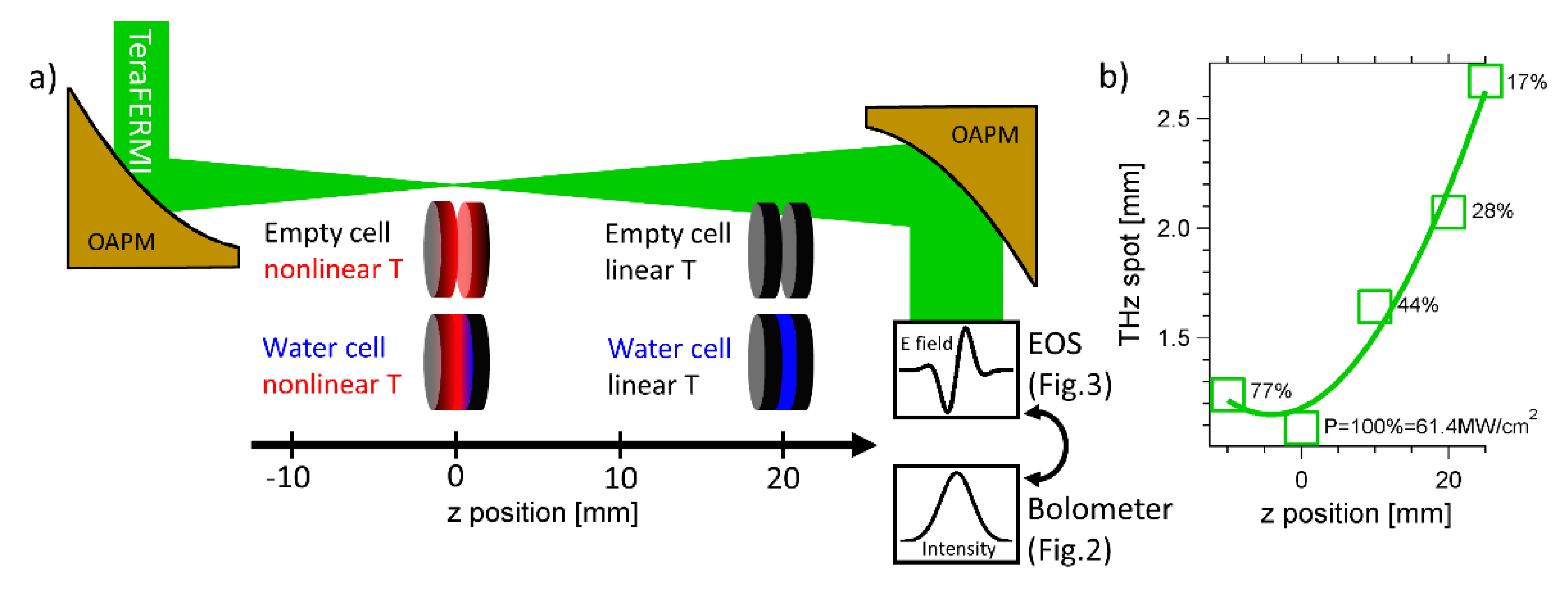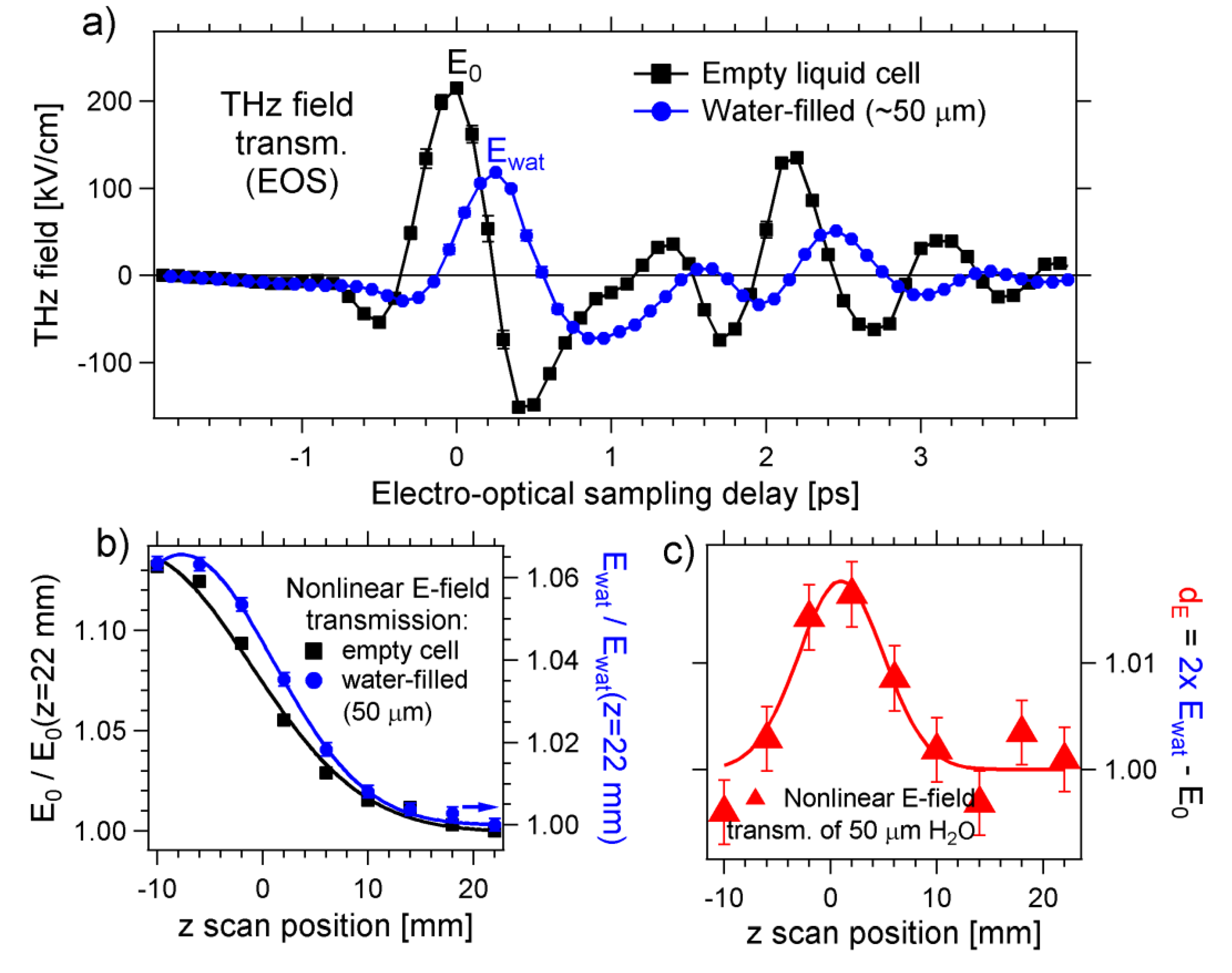Nonlinear TeraHertz Transmission by Liquid Water at 1 THz
Abstract
:1. Introduction
2. Materials and Methods
3. Results and Discussion
Author Contributions
Funding
Acknowledgments
Conflicts of Interest
References
- Zelsmann, H.R. Temperature dependence of the optical constants for liquid H2O and D2O in the far IR region. J. Mol. Struct. 1995, 350, 95–114. [Google Scholar] [CrossRef]
- Bertie, J.E.; Lan, Z. Infrared Intensities of Liquids XX: The Intensity of the OH Stretching Band of Liquid Water Revisited, and the Best Current Values of the Optical Constants of H 2 O(l) at 25 °C between 15,000 and 1 cm−1. Appl. Spectrosc. 1996, 50, 1047–1057. [Google Scholar] [CrossRef]
- Ellison, W.J. Permittivity of Pure Water, at Standard Atmospheric Pressure, over the Frequency Range 0–25 THz and the Temperature Range 0–100 °C. J. Phys. Chem. Ref. Data 2007, 36, 1–18. [Google Scholar] [CrossRef]
- Novelli, F.; Guchhait, B.; Havenith, M. Towards Intense THz Spectroscopy on Water: Characterization of Optical Rectification by GaP, OH1, and DSTMS at OPA Wavelengths. Materials 2020, 13, 1311. [Google Scholar] [CrossRef] [Green Version]
- Heyden, M.; Sun, J.; Funkner, S.; Mathias, G.; Forbert, H.; Havenith, M.; Marx, D. Dissecting the THz spectrum of liquid water from first principles via correlations in time and space. Proc. Natl. Acad. Sci. USA 2010, 107, 12068–12073. [Google Scholar] [CrossRef] [Green Version]
- Novelli, F.; Bernal Lopez, M.; Schwaab, G.; Roldan Cuenya, B.; Havenith, M. Water Solvation of Charged and Neutral Gold Nanoparticles. J. Phys. Chem. B 2019, 123, 6521–6528. [Google Scholar] [CrossRef]
- Alfarano, S.R.; Vondracek, H.; Sebastiani, F.; Novelli, F.; Hoberg, C.; Kolling, I.; Brubach, J.-B.; Roy, P.; Schwaab, G.; Havenith, M.; et al. Does hydrated glycine act as solidification nucleus at multi-kilobar conditions? Biophys. Chem. 2019, 253, 106215. [Google Scholar] [CrossRef]
- Vondracek, H.; Alfarano, S.; Hoberg, C.; Kolling, I.; Novelli, F.; Sebastiani, F.; Brubach, J.-B.; Roy, P.; Schwaab, G.; Havenith, M.; et al. Urea’s match in the hydrogen-bond network? A high pressure THz study. Biophys. Chem. 2019, 254, 106240. [Google Scholar] [CrossRef]
- Bergonzi, I.; Mercury, L.; Brubach, J.-B.; Roy, P. Gibbs free energy of liquid water derived from infrared measurements. Phys. Chem. Chem. Phys. 2014, 16, 24830–24840. [Google Scholar] [CrossRef] [Green Version]
- Ball, P. Water — an enduring mystery. Nature 2008, 452, 291–292. [Google Scholar] [CrossRef]
- Nilsson, A.; Pettersson, L.G.M. The structural origin of anomalous properties of liquid water. Nat. Commun. 2015, 6, 8998. [Google Scholar] [CrossRef] [PubMed] [Green Version]
- Mukherjee, A.; Lavery, R.; Bagchi, B.; Hynes, J.T. On the molecular mechanism of drug intercalation into DNA: A simulation study of the intercalation pathway, free energy, and DNA structural changes. J. Am. Chem. Soc. 2008, 130, 9747–9755. [Google Scholar] [CrossRef] [PubMed]
- Wilhelm, M.; Mukherjee, A.; Bouvier, B.; Zakrzewska, K.; Hynes, J.T.; Lavery, R. Multistep drug intercalation: Molecular dynamics and free energy studies of the binding of daunomycin to DNA. J. Am. Chem. Soc. 2012, 134, 8588–8596. [Google Scholar] [CrossRef] [PubMed] [Green Version]
- Cassone, G.; Sponer, J.; Trusso, S.; Saija, F. Ab initio spectroscopy of water under electric fields. Phys. Chem. Chem. Phys. 2019, 21, 21205–21212. [Google Scholar] [CrossRef] [PubMed]
- Sommers, G.M.; Calegari Andrade, M.F.; Zhang, L.; Wang, H.; Car, R. Raman spectrum and polarizability of liquid water from deep neural networks. Phys. Chem. Chem. Phys. 2020, 22, 10592–10602. [Google Scholar] [CrossRef]
- Savolainen, J.; Ahmed, S.; Hamm, P. Two-dimensional Raman-terahertz spectroscopy of water. Proc. Natl. Acad. Sci. USA 2013, 110, 20402–20407. [Google Scholar] [CrossRef] [Green Version]
- Shalit, A.; Ahmed, S.; Savolainen, J.; Hamm, P. Terahertz echoes reveal the inhomogeneity of aqueous salt solutions. Nat. Chem. 2017, 9, 273–278. [Google Scholar] [CrossRef]
- Sidler, D.; Hamm, P. Feynman diagram description of 2D-Raman-THz spectroscopy applied to water. J. Chem. Phys. 2019, 150, 044202. [Google Scholar] [CrossRef] [Green Version]
- Zalden, P.; Song, L.; Wu, X.; Huang, H.; Ahr, F.; Mücke, O.D.; Reichert, J.; Thorwart, M.; Mishra, P.K.; Welsch, R.; et al. Molecular polarizability anisotropy of liquid water revealed by terahertz-induced transient orientation. Nat. Commun. 2018, 9, 2142. [Google Scholar] [CrossRef]
- Taschin, A.; Bartolini, P.; Eramo, R.; Righini, R.; Torre, R. Evidence of two distinct local structures of water from ambient to supercooled conditions. Nat. Commun. 2013, 4, 2401. [Google Scholar] [CrossRef] [Green Version]
- Taschin, A.; Bartolini, P.; Fanetti, S.; Lapini, A.; Citroni, M.; Righini, R.; Bini, R.; Torre, R. Pressure Effects on Water Dynamics by Time-Resolved Optical Kerr Effect. J. Phys. Chem. Lett. 2020, 11, 3063–3068. [Google Scholar] [CrossRef] [PubMed]
- Elgabarty, H.; Kampfrath, T.; Bonthuis, D.J.; Balos, V.; Kaliannan, N.K.; Loche, P.; Netz, R.R.; Wolf, M.; Kühne, T.D.; Sajadi, M. Energy transfer within the hydrogen bonding network of water following resonant terahertz excitation. Sci. Adv. 2020, 6, eaay7074. [Google Scholar] [CrossRef] [PubMed] [Green Version]
- Tcypkin, A.N.; Melnik, M.V.; Zhukova, M.O.; Vorontsova, I.O.; Putilin, S.E.; Kozlov, S.A.; Zhang, X.-C. High Kerr nonlinearity of water in THz spectral range. Opt. Express 2019, 27, 10419. [Google Scholar] [CrossRef] [PubMed] [Green Version]
- Novelli, F.; Ruiz Pestana, L.; Bennett, K.C.; Sebastiani, F.; Adams, E.M.; Stavrias, N.; Ockelmann, T.; Colchero, A.; Hoberg, C.; Schwaab, G.; et al. Strong Anisotropy in Liquid Water upon Librational Excitation Using Terahertz Laser Fields. J. Phys. Chem. B 2020, 124, 4989–5001. [Google Scholar] [CrossRef] [PubMed]
- Elgabarty, H.; Kühne, T.D. Tumbling with a limp: Local asymmetry in water’s hydrogen bond network and its consequences. Phys. Chem. Chem. Phys. 2020, 22, 10397–10411. [Google Scholar] [CrossRef] [Green Version]
- Sheik-Bahae, M.; Said, A.A.; Wei, T.-H.; Hagan, D.J.; Van Stryland, E.W. Sensitive measurement of optical nonlinearities using a single beam. IEEE J. Quantum Electron. 1990, 26, 760–769. [Google Scholar] [CrossRef] [Green Version]
- Zheng, X.; Chen, R.; Shi, G.; Zhang, J.; Xu, Z.; Cheng, X.; Jiang, T. Characterization of nonlinear properties of black phosphorus nanoplatelets with femtosecond pulsed Z-scan measurements. Opt. Lett. 2015, 40, 3480. [Google Scholar] [CrossRef]
- Melnik, M.; Vorontsova, I.; Putilin, S.; Tcypkin, A.; Kozlov, S. Methodical inaccuracy of the Z-scan method for few-cycle terahertz pulses. Sci. Rep. 2019, 9, 9146. [Google Scholar] [CrossRef] [Green Version]
- Hoberg, C.; Balzerowski, P.; Havenith, M. Integration of a rapid scanning technique into THz time-domain spectrometers for nonlinear THz spectroscopy measurements. AIP Adv. 2019, 9, 035348. [Google Scholar] [CrossRef]
- Pupeza, I.; Huber, M.; Trubetskov, M.; Schweinberger, W.; Hussain, S.A.; Hofer, C.; Fritsch, K.; Poetzlberger, M.; Vamos, L.; Fill, E.; et al. Field-resolved infrared spectroscopy of biological systems. Nature 2020, 577, 52–59. [Google Scholar] [CrossRef]
- Novelli, F.; Ostovar Pour, S.; Tollerud, J.; Roozbeh, A.; Appadoo, D.R.T.T.; Blanch, E.W.; Davis, J.A. Time-Domain THz Spectroscopy Reveals Coupled Protein–Hydration Dielectric Response in Solutions of Native and Fibrils of Human Lysozyme. J. Phys. Chem. B 2017, 121, 4810–4816. [Google Scholar] [CrossRef] [PubMed] [Green Version]
- Adhlakha, N.; Di Pietro, P.; Piccirilli, F.; Cinquegrana, P.; Di Mitri, S.; Sigalotti, P.; Spampinati, S.; Veronese, M.; Lupi, S.; Perucchi, A. The TeraFERMI Electro-Optic Sampling Set-Up for Fluence-Dependent Spectroscopic Measurements. Condens. Matter 2020, 5, 8. [Google Scholar] [CrossRef] [Green Version]
- Novelli, F.; Chon, J.W.M.; Davis, J.A. Terahertz thermometry of gold nanospheres in water. Opt. Lett. 2016, 41, 5801. [Google Scholar] [CrossRef] [PubMed]
- Luong, T.Q.; Xu, Y.; Bründermann, E.; Leitner, D.M.; Havenith, M. Hydrophobic collapse induces changes in the collective protein and hydration low frequency modes. Chem. Phys. Lett. 2016, 651, 1–7. [Google Scholar] [CrossRef]
- Casalbuoni, S.; Schlarb, H.; Schmidt, B.; Schmüser, P.; Steffen, B.; Winter, A. Numerical studies on the electro-optic detection of femtosecond electron bunches. Phys. Rev. Spec. Top.-Accel. Beams 2008, 11, 072802. [Google Scholar] [CrossRef] [Green Version]
- Adams, E.M.; Lampret, O.; König, B.; Happe, T.; Havenith, M. Solvent dynamics play a decisive role in the complex formation of biologically relevant redox proteins. Phys. Chem. Chem. Phys. 2020, 22, 7451–7459. [Google Scholar] [CrossRef]
- Hebling, J.; Hoffmann, M.C.; Hwang, H.Y.; Yeh, K.-L.; Nelson, K.A. Observation of nonequilibrium carrier distribution in Ge, Si, and GaAs by terahertz pump–terahertz probe measurements. Phys. Rev. B 2010, 81, 035201. [Google Scholar] [CrossRef]
- Beard, M.C.; Turner, G.M.; Schmuttenmaer, C.A. Terahertz Spectroscopy. J. Phys. Chem. B 2002, 106, 7146–7159. [Google Scholar] [CrossRef]
- Shafiei, M.; von Domaros, M.; Bratko, D.; Luzar, A. Anisotropic structure and dynamics of water under static electric fields. J. Chem. Phys. 2019, 150, 074505. [Google Scholar] [CrossRef]
- Shafiei, M.; Ojaghlou, N.; Zamfir, S.G.; Bratko, D.; Luzar, A. Modulation of structure and dynamics of water under alternating electric field and the role of hydrogen bonding. Mol. Phys. 2019, 117, 3282–3296. [Google Scholar] [CrossRef]
- Huang, H.H.; Nagashima, T.; Yonezawa, T.; Matsuo, Y.; Ng, S.H.; Juodkazis, S.; Hatanaka, K. Giant enhancement of THz wave emission under double-pulse excitation of thin water flow. Appl. Sci. 2020, 10, 2031. [Google Scholar] [CrossRef] [Green Version]
- Yiwen, E.; Jin, Q.; Zhang, X.C. Enhancement of terahertz emission by a preformed plasma in liquid water. Appl. Phys. Lett. 2019, 115, 1–5. [Google Scholar]
- Tsubouchi, M.; Hoshina, H.; Nagai, M.; Isoyama, G. Plane photoacoustic wave generation in liquid water using irradiation of terahertz pulses. arXiv 2019, arXiv:1911.04674. [Google Scholar]



© 2020 by the authors. Licensee MDPI, Basel, Switzerland. This article is an open access article distributed under the terms and conditions of the Creative Commons Attribution (CC BY) license (http://creativecommons.org/licenses/by/4.0/).
Share and Cite
Novelli, F.; Ma, C.Y.; Adhlakha, N.; Adams, E.M.; Ockelmann, T.; Das Mahanta, D.; Di Pietro, P.; Perucchi, A.; Havenith, M. Nonlinear TeraHertz Transmission by Liquid Water at 1 THz. Appl. Sci. 2020, 10, 5290. https://doi.org/10.3390/app10155290
Novelli F, Ma CY, Adhlakha N, Adams EM, Ockelmann T, Das Mahanta D, Di Pietro P, Perucchi A, Havenith M. Nonlinear TeraHertz Transmission by Liquid Water at 1 THz. Applied Sciences. 2020; 10(15):5290. https://doi.org/10.3390/app10155290
Chicago/Turabian StyleNovelli, Fabio, Chun Yu Ma, Nidhi Adhlakha, Ellen M. Adams, Thorsten Ockelmann, Debasish Das Mahanta, Paola Di Pietro, Andrea Perucchi, and Martina Havenith. 2020. "Nonlinear TeraHertz Transmission by Liquid Water at 1 THz" Applied Sciences 10, no. 15: 5290. https://doi.org/10.3390/app10155290
APA StyleNovelli, F., Ma, C. Y., Adhlakha, N., Adams, E. M., Ockelmann, T., Das Mahanta, D., Di Pietro, P., Perucchi, A., & Havenith, M. (2020). Nonlinear TeraHertz Transmission by Liquid Water at 1 THz. Applied Sciences, 10(15), 5290. https://doi.org/10.3390/app10155290







